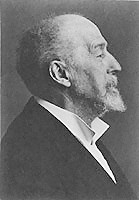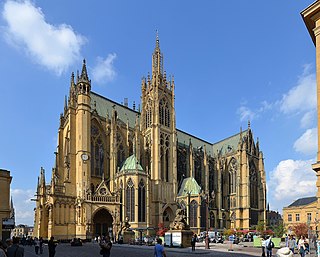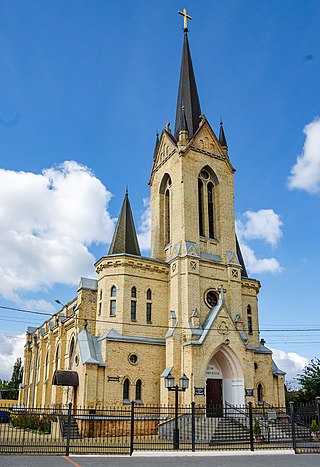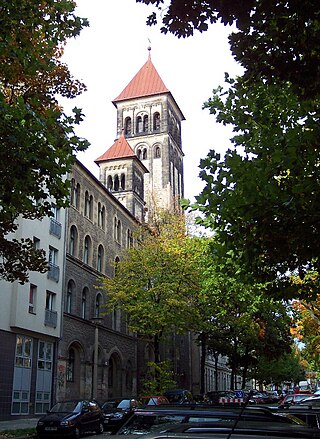
Graz is the capital of the Austrian federal state of Styria and the second-largest city in Austria, after Vienna. As of 1 January 2024, Graz had a population of 303,270. In 2023, the population of the Graz larger urban zone (LUZ) stood at 660,238. Graz is known as a college and university city, with four colleges and four universities. Combined, the city is home to more than 60,000 students. Its historic centre (Altstadt) is one of the best-preserved city centres in Central Europe.

A Gesamtkunstwerk is a work of art that makes use of all or many art forms or strives to do so. The term is a German loanword accepted in English as a term in aesthetics.

Otto Koloman Wagner was an Austrian architect, furniture designer and urban planner. He was a leading member of the Vienna Secession movement of architecture, founded in 1897, and the broader Art Nouveau movement. Many of his works are found in his native city of Vienna, and illustrate the rapid evolution of architecture during the period. His early works were inspired by classical architecture. By mid-1890s, he had already designed several buildings in what became known as the Vienna Secession style. Beginning in 1898, with his designs of Vienna Metro stations, his style became floral and Art Nouveau, with decoration by Koloman Moser. His later works, 1906 until his death in 1918, had geometric forms and minimal ornament, clearly expressing their function. They are considered predecessors to modern architecture.

Kirche am Steinhof, also called the Church of St. Leopold, is the Roman Catholic oratory of the Otto-Wagner-Spital in the area of Steinhof in Vienna, Austria. The building, designed by Otto Wagner, is considered one of the most important Art Nouveau churches in the world.

Metz Cathedral is the cathedral of the Catholic Diocese of Metz, the seat of the bishops of Metz. It is dedicated to Saint Stephen. The diocese dates back at least to the 4th century and the present cathedral building was begun in the early 14th century. In the mid-14th century, it was joined to the collegiate church of Notre-Dame, and given a new transept and late Gothic chevet, finished between 1486 and 1520. The cathedral treasury displays a rich collection assembled over the long centuries of the history of the Metz diocese and include sacred vestments and items used for the Eucharist.

Illingen is a municipality in the district of Neunkirchen, in Saarland, Germany. It is situated approximately 10 km northwest of Neunkirchen, and 17 km northeast of Saarbrücken.

The German Church, sometimes called St. Gertrude's Church, is a church in Gamla stan, the old town in central Stockholm, Sweden, belonging to the German Saint Gertrude Parish of the Church of Sweden.
Othmar Schimkowitz was a Hungarian-born architectural sculptor who worked on the greatest landmarks of the Vienna Secession.

Alois Johannes Plum was an artist working in Mainz, Germany, who has acquired a national reputation for his stained glass, his paintings, and his plastic art. Plum has been active since the 1950s and his work decorates hundreds of churches and public buildings in Germany. He has created many characteristic stained glass windows in churches renovated or rebuilt after the destruction of World War II, and is especially noted for his reinterpretation of historic sacred space and his integration of glass and architecture with careful attention to the liturgical function of his art.

Linz Hauptbahnhof or Linz Central Station is a railway station in Linz, the third largest city in Austria, and capital city of the federal state of Upper Austria. Opened in 1858, the station is the centrepiece of the Linz transport hub. It forms part of the Western Railway, and is also a terminus of the Pyhrn Railway, the Summerauer Railway, and the Linzer Lokalbahn (LILO). The station is owned by the Austrian Federal Railways (ÖBB); train services are operated by the ÖBB and the LILO. With 40,800 passengers daily in 2018/2019, it is the busiest station in Austria outside of Vienna, and the 7th-busiest overall.

House of the Gospel in Lutsk, Ukraine, is a Baptist church. It is located in "Old Lutsk", the historical and architectural part of the city.

The Catholic Herz-Jesu-Kirche is a Neo-Gothic hall church located in the borough Mombach of the German city of Mainz. It is dedicated to the Sacred Heart. The church calendar of 1911 says: The name "Sacred Heart Church" originated from the idea to honour the memory of the great social bishop von Ketteler, who throughout his life was a pious and zealous admirer of the Sacred Heart, in his hundredth year of birth.

Leopold Forstner was an artist who was part of the Viennese Secession movement, working in the Jugendstil style, focusing particularly on the mosaic as a form.

Herz Jesu Fechenheim is a Catholic church in the suburb Fechenheim of Frankfurt am Main, Hesse, Germany. The parish church of the Fechenheim congregation is part of the Roman Catholic Diocese of Limburg. On 1 January 2015 the parish became a Kirchort, part of the parish St. Josef Frankfurt am Main.

Herz Jesu Oberrad is a Catholic church in the suburb Oberrad of Frankfurt am Main, Hesse, Germany. The parish church of the Oberrad congregation is part of the Diocese of Limburg. It is a Kirchort, part of the parish St. Bonifatius Frankfurt.
Alexander Beleschenko is a British artist working in glass who creates architectural glass installations.

The Sacred Heart Church is a Catholic church located in Berlin-Prenzlauer Berg, externally built in Neo-Romanesque style. Designed by Christoph Hehl, professor of medieval architecture, the building was completed after 16 months of constructions in 1898. The Neo-Byzantine-style murals inside the church were done by Friedrich Stummel.

Georg von Hauberrisser was a German-Austrian architect.
Herz-Jesu-Kirche is a church in Graz, Austria.

Herz-Jesu-Kirche is a Catholic Church in the Neuhausen-Nymphenburg borough of Munich, Bavaria, Germany. It is part of the Archdiocese of Munich and Freising. The church was consecrated by archbishop Friedrich Wetter on 26 November 2000.


















